Developmental Psychology: A Case Study
VerifiedAdded on 2023/04/10
|13
|2424
|146
AI Summary
This case study explores the developmental psychology of an 8-year-old boy named Jason. It covers his physical, cognitive, social, and personality development, as well as the application of psychological theories.
Contribute Materials
Your contribution can guide someone’s learning journey. Share your
documents today.
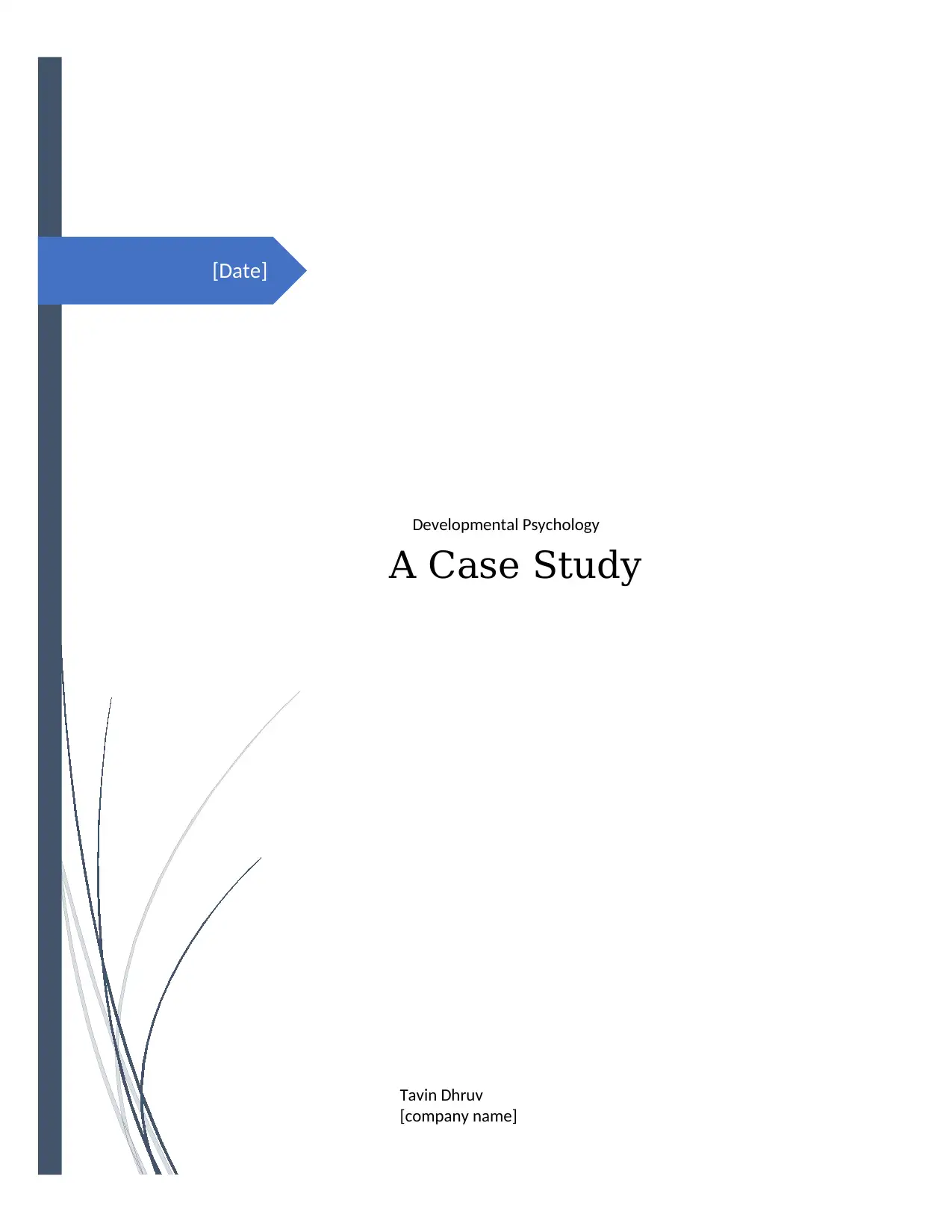
[Date]
Developmental Psychology
A Case Study
Tavin Dhruv
[company name]
Developmental Psychology
A Case Study
Tavin Dhruv
[company name]
Secure Best Marks with AI Grader
Need help grading? Try our AI Grader for instant feedback on your assignments.

Introduction
Background of Jason
The human subject for this case study is an 8-year-old boy named, Jason
who studies in 3rd grade in Hillmount public school in Ontario, Toronto. He
is an extremely playful child who loves to socialize and one of the most
active child in his class. When asked about his favorite animal, he excitedly
answered, Colossal squid and sometimes he has a habit of suddenly clawing
his fingers to imitate its hand movements. He also loves to draw, and mostly
he likes to draw dinosaurs and scary things. To him scary things are those
things who have spikes. When he showed his drawing book, there was a
house that he drew had spikes, a man who was wearing the black shoes had
spikes around him and a girl long hair with spikes.
Mother of Jason mentioned that, teachers at school are not very sure about
which subject Jason excels in, because despite being active, he still often
requires help in his academics. He also faces a hard time in doing his
homework all by himself. On most days, he stays back at school for getting
tutored because if he does not stay back then his homework will be
incomplete the next day. Jason is a only child to his parents, so due to
extreme pampering he often gets whatever he demands from his parents,
toys, stationary, chocolates, etc. and if his demands are not fulfilled he will
throw tantrums like not eating, closing his room and he gets very cranky.
Background of Jason
The human subject for this case study is an 8-year-old boy named, Jason
who studies in 3rd grade in Hillmount public school in Ontario, Toronto. He
is an extremely playful child who loves to socialize and one of the most
active child in his class. When asked about his favorite animal, he excitedly
answered, Colossal squid and sometimes he has a habit of suddenly clawing
his fingers to imitate its hand movements. He also loves to draw, and mostly
he likes to draw dinosaurs and scary things. To him scary things are those
things who have spikes. When he showed his drawing book, there was a
house that he drew had spikes, a man who was wearing the black shoes had
spikes around him and a girl long hair with spikes.
Mother of Jason mentioned that, teachers at school are not very sure about
which subject Jason excels in, because despite being active, he still often
requires help in his academics. He also faces a hard time in doing his
homework all by himself. On most days, he stays back at school for getting
tutored because if he does not stay back then his homework will be
incomplete the next day. Jason is a only child to his parents, so due to
extreme pampering he often gets whatever he demands from his parents,
toys, stationary, chocolates, etc. and if his demands are not fulfilled he will
throw tantrums like not eating, closing his room and he gets very cranky.
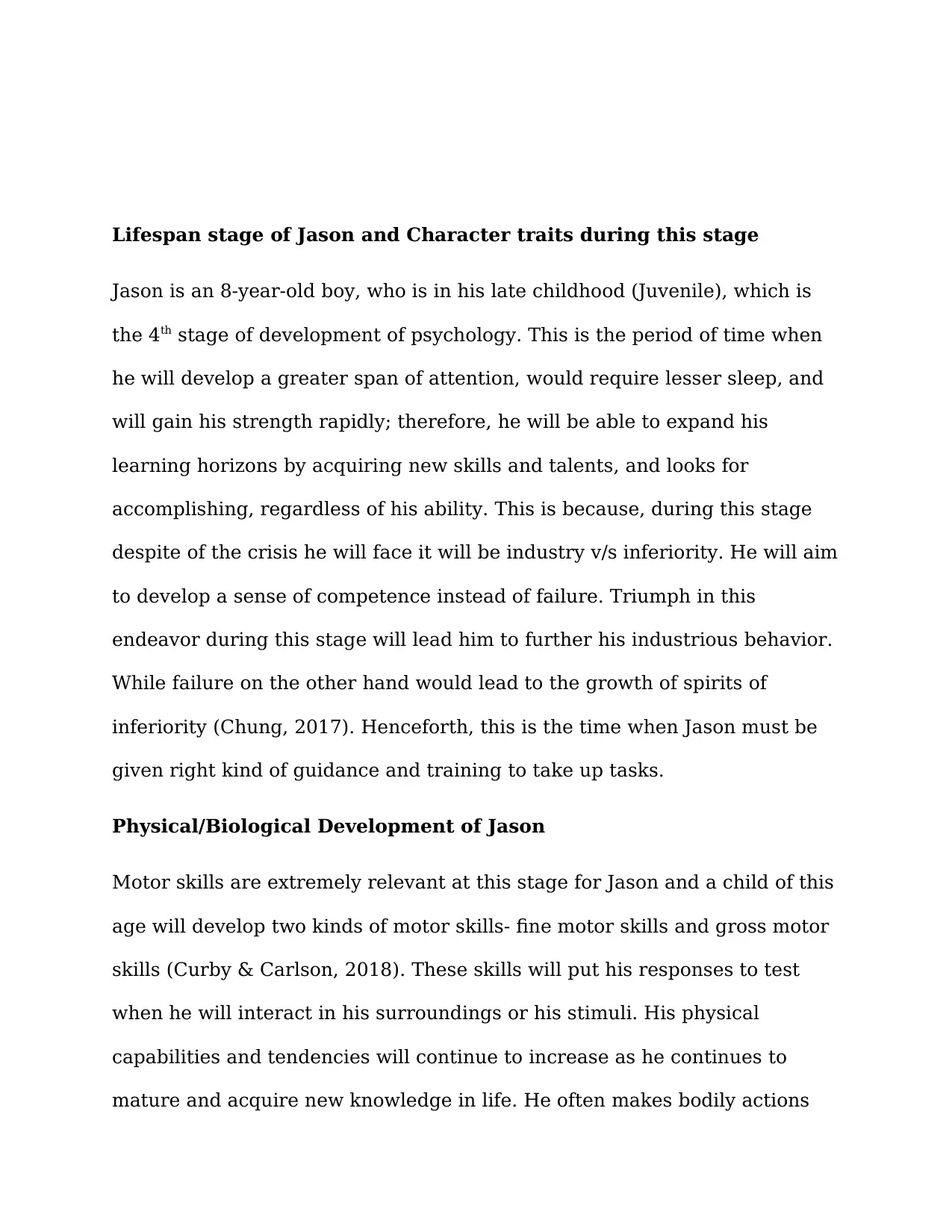
Lifespan stage of Jason and Character traits during this stage
Jason is an 8-year-old boy, who is in his late childhood (Juvenile), which is
the 4th stage of development of psychology. This is the period of time when
he will develop a greater span of attention, would require lesser sleep, and
will gain his strength rapidly; therefore, he will be able to expand his
learning horizons by acquiring new skills and talents, and looks for
accomplishing, regardless of his ability. This is because, during this stage
despite of the crisis he will face it will be industry v/s inferiority. He will aim
to develop a sense of competence instead of failure. Triumph in this
endeavor during this stage will lead him to further his industrious behavior.
While failure on the other hand would lead to the growth of spirits of
inferiority (Chung, 2017). Henceforth, this is the time when Jason must be
given right kind of guidance and training to take up tasks.
Physical/Biological Development of Jason
Motor skills are extremely relevant at this stage for Jason and a child of this
age will develop two kinds of motor skills- fine motor skills and gross motor
skills (Curby & Carlson, 2018). These skills will put his responses to test
when he will interact in his surroundings or his stimuli. His physical
capabilities and tendencies will continue to increase as he continues to
mature and acquire new knowledge in life. He often makes bodily actions
Jason is an 8-year-old boy, who is in his late childhood (Juvenile), which is
the 4th stage of development of psychology. This is the period of time when
he will develop a greater span of attention, would require lesser sleep, and
will gain his strength rapidly; therefore, he will be able to expand his
learning horizons by acquiring new skills and talents, and looks for
accomplishing, regardless of his ability. This is because, during this stage
despite of the crisis he will face it will be industry v/s inferiority. He will aim
to develop a sense of competence instead of failure. Triumph in this
endeavor during this stage will lead him to further his industrious behavior.
While failure on the other hand would lead to the growth of spirits of
inferiority (Chung, 2017). Henceforth, this is the time when Jason must be
given right kind of guidance and training to take up tasks.
Physical/Biological Development of Jason
Motor skills are extremely relevant at this stage for Jason and a child of this
age will develop two kinds of motor skills- fine motor skills and gross motor
skills (Curby & Carlson, 2018). These skills will put his responses to test
when he will interact in his surroundings or his stimuli. His physical
capabilities and tendencies will continue to increase as he continues to
mature and acquire new knowledge in life. He often makes bodily actions
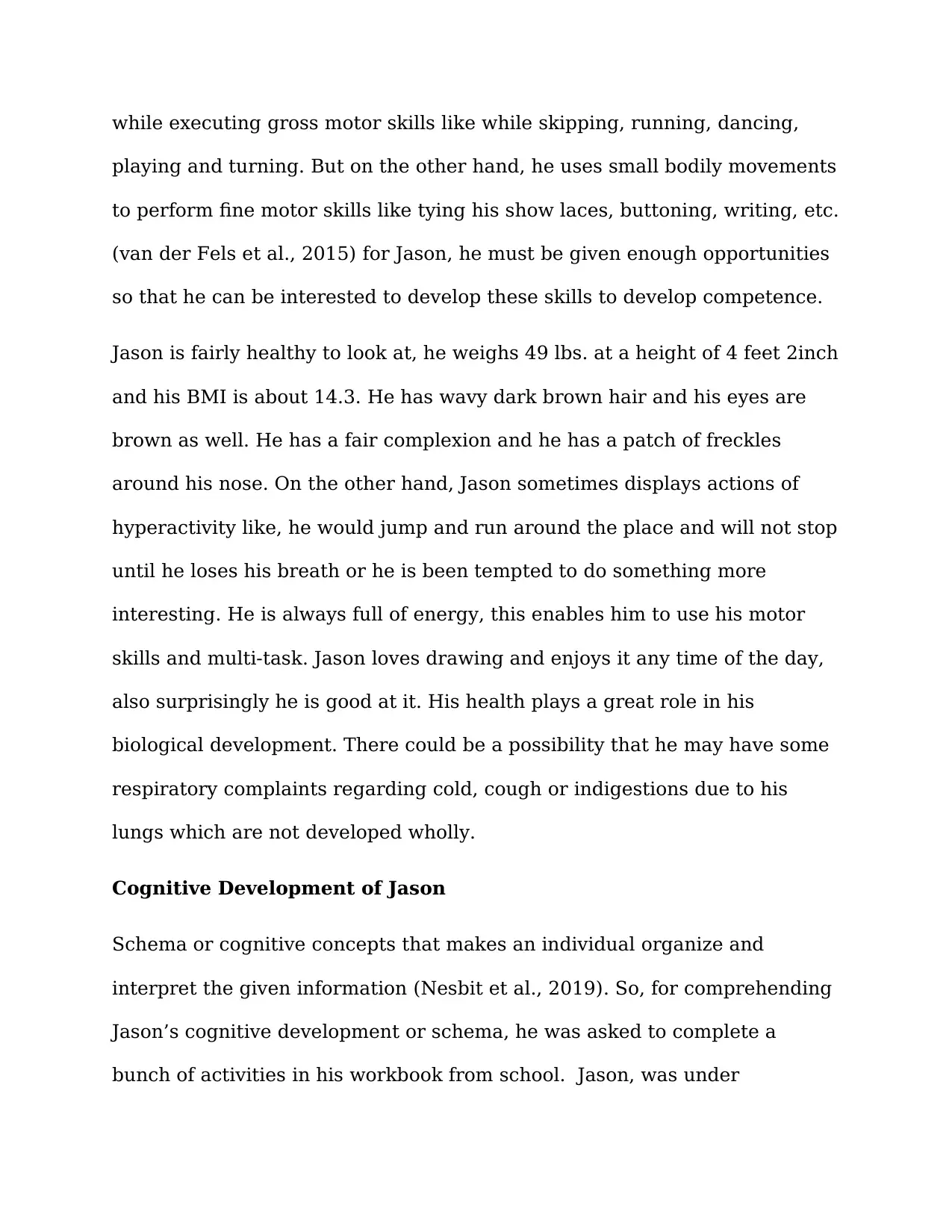
while executing gross motor skills like while skipping, running, dancing,
playing and turning. But on the other hand, he uses small bodily movements
to perform fine motor skills like tying his show laces, buttoning, writing, etc.
(van der Fels et al., 2015) for Jason, he must be given enough opportunities
so that he can be interested to develop these skills to develop competence.
Jason is fairly healthy to look at, he weighs 49 lbs. at a height of 4 feet 2inch
and his BMI is about 14.3. He has wavy dark brown hair and his eyes are
brown as well. He has a fair complexion and he has a patch of freckles
around his nose. On the other hand, Jason sometimes displays actions of
hyperactivity like, he would jump and run around the place and will not stop
until he loses his breath or he is been tempted to do something more
interesting. He is always full of energy, this enables him to use his motor
skills and multi-task. Jason loves drawing and enjoys it any time of the day,
also surprisingly he is good at it. His health plays a great role in his
biological development. There could be a possibility that he may have some
respiratory complaints regarding cold, cough or indigestions due to his
lungs which are not developed wholly.
Cognitive Development of Jason
Schema or cognitive concepts that makes an individual organize and
interpret the given information (Nesbit et al., 2019). So, for comprehending
Jason’s cognitive development or schema, he was asked to complete a
bunch of activities in his workbook from school. Jason, was under
playing and turning. But on the other hand, he uses small bodily movements
to perform fine motor skills like tying his show laces, buttoning, writing, etc.
(van der Fels et al., 2015) for Jason, he must be given enough opportunities
so that he can be interested to develop these skills to develop competence.
Jason is fairly healthy to look at, he weighs 49 lbs. at a height of 4 feet 2inch
and his BMI is about 14.3. He has wavy dark brown hair and his eyes are
brown as well. He has a fair complexion and he has a patch of freckles
around his nose. On the other hand, Jason sometimes displays actions of
hyperactivity like, he would jump and run around the place and will not stop
until he loses his breath or he is been tempted to do something more
interesting. He is always full of energy, this enables him to use his motor
skills and multi-task. Jason loves drawing and enjoys it any time of the day,
also surprisingly he is good at it. His health plays a great role in his
biological development. There could be a possibility that he may have some
respiratory complaints regarding cold, cough or indigestions due to his
lungs which are not developed wholly.
Cognitive Development of Jason
Schema or cognitive concepts that makes an individual organize and
interpret the given information (Nesbit et al., 2019). So, for comprehending
Jason’s cognitive development or schema, he was asked to complete a
bunch of activities in his workbook from school. Jason, was under
Secure Best Marks with AI Grader
Need help grading? Try our AI Grader for instant feedback on your assignments.
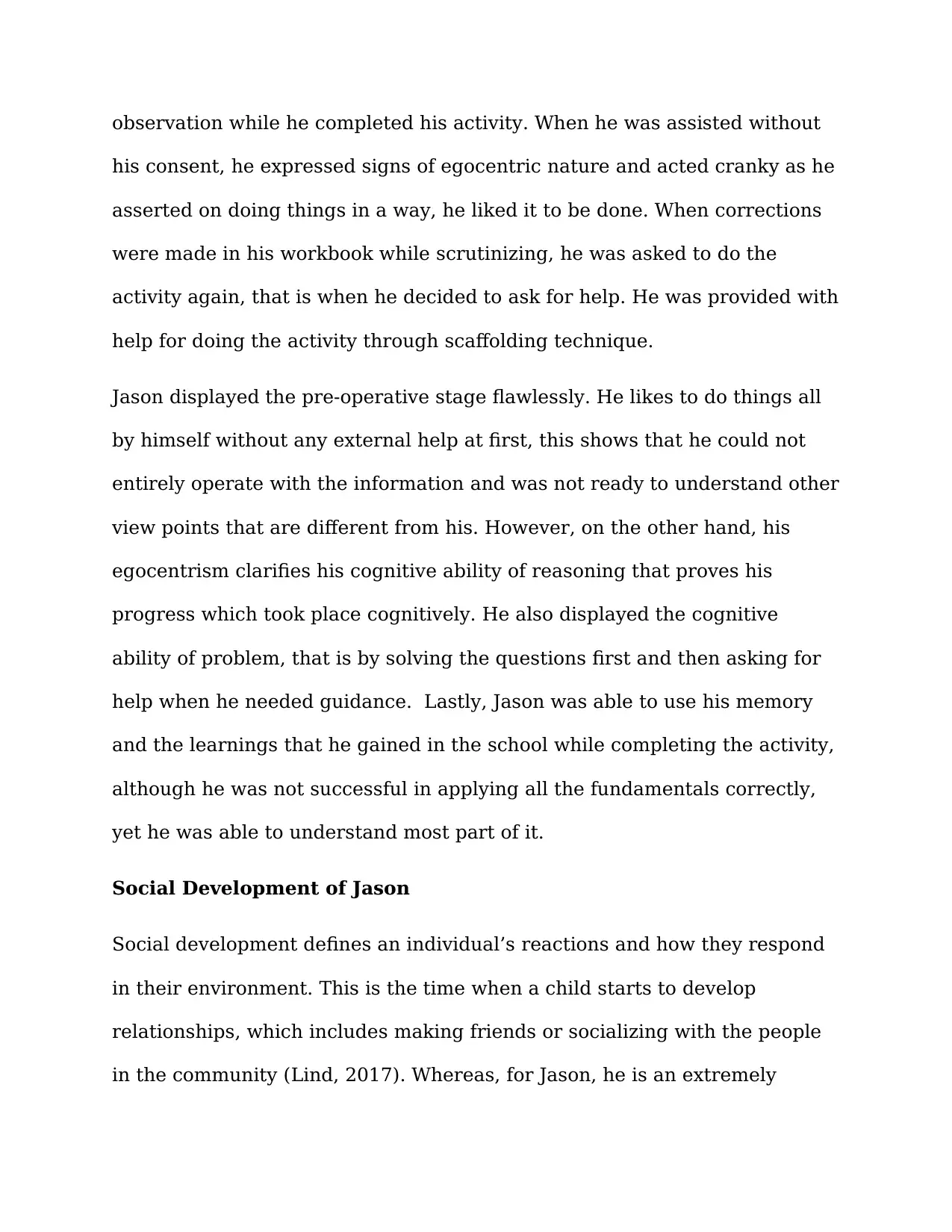
observation while he completed his activity. When he was assisted without
his consent, he expressed signs of egocentric nature and acted cranky as he
asserted on doing things in a way, he liked it to be done. When corrections
were made in his workbook while scrutinizing, he was asked to do the
activity again, that is when he decided to ask for help. He was provided with
help for doing the activity through scaffolding technique.
Jason displayed the pre-operative stage flawlessly. He likes to do things all
by himself without any external help at first, this shows that he could not
entirely operate with the information and was not ready to understand other
view points that are different from his. However, on the other hand, his
egocentrism clarifies his cognitive ability of reasoning that proves his
progress which took place cognitively. He also displayed the cognitive
ability of problem, that is by solving the questions first and then asking for
help when he needed guidance. Lastly, Jason was able to use his memory
and the learnings that he gained in the school while completing the activity,
although he was not successful in applying all the fundamentals correctly,
yet he was able to understand most part of it.
Social Development of Jason
Social development defines an individual’s reactions and how they respond
in their environment. This is the time when a child starts to develop
relationships, which includes making friends or socializing with the people
in the community (Lind, 2017). Whereas, for Jason, he is an extremely
his consent, he expressed signs of egocentric nature and acted cranky as he
asserted on doing things in a way, he liked it to be done. When corrections
were made in his workbook while scrutinizing, he was asked to do the
activity again, that is when he decided to ask for help. He was provided with
help for doing the activity through scaffolding technique.
Jason displayed the pre-operative stage flawlessly. He likes to do things all
by himself without any external help at first, this shows that he could not
entirely operate with the information and was not ready to understand other
view points that are different from his. However, on the other hand, his
egocentrism clarifies his cognitive ability of reasoning that proves his
progress which took place cognitively. He also displayed the cognitive
ability of problem, that is by solving the questions first and then asking for
help when he needed guidance. Lastly, Jason was able to use his memory
and the learnings that he gained in the school while completing the activity,
although he was not successful in applying all the fundamentals correctly,
yet he was able to understand most part of it.
Social Development of Jason
Social development defines an individual’s reactions and how they respond
in their environment. This is the time when a child starts to develop
relationships, which includes making friends or socializing with the people
in the community (Lind, 2017). Whereas, for Jason, he is an extremely
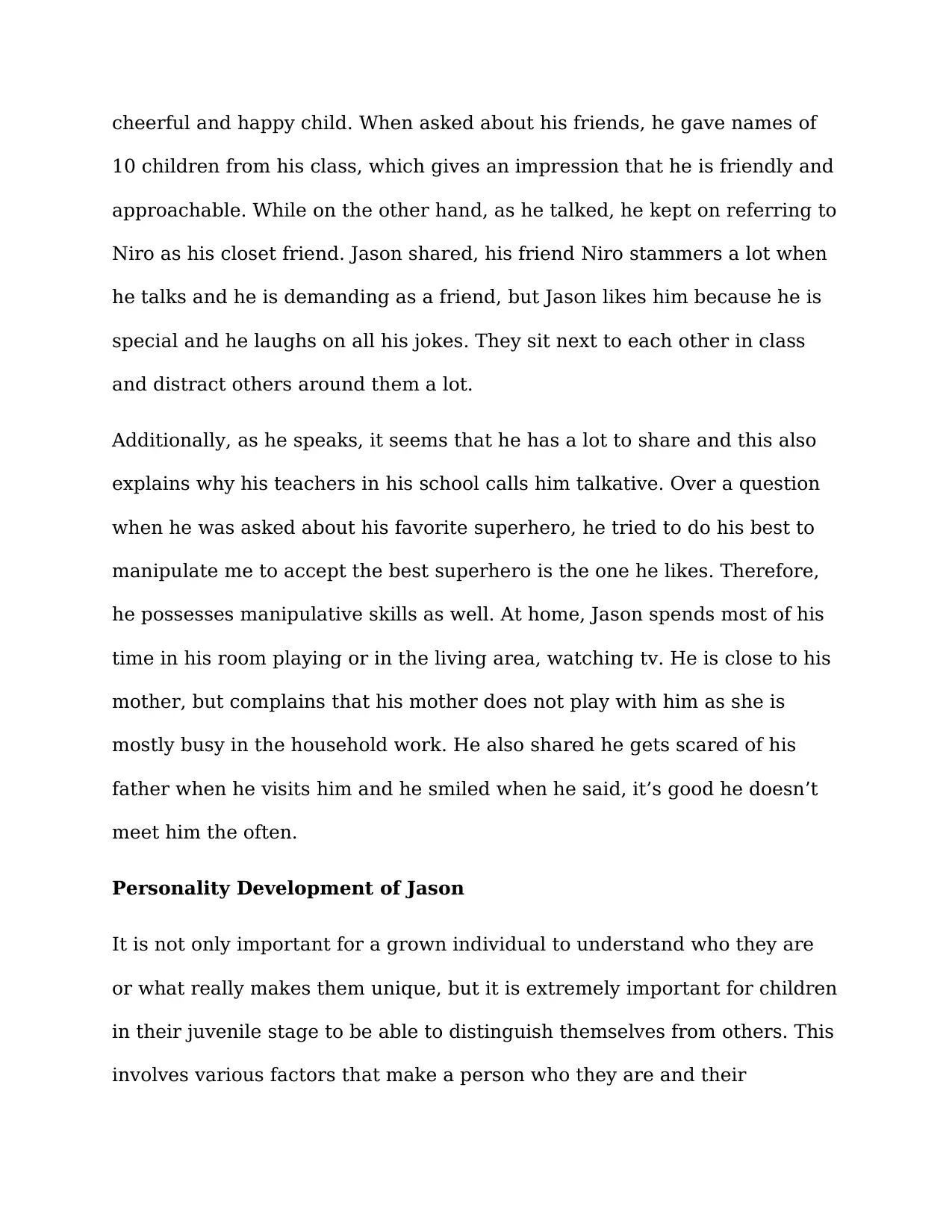
cheerful and happy child. When asked about his friends, he gave names of
10 children from his class, which gives an impression that he is friendly and
approachable. While on the other hand, as he talked, he kept on referring to
Niro as his closet friend. Jason shared, his friend Niro stammers a lot when
he talks and he is demanding as a friend, but Jason likes him because he is
special and he laughs on all his jokes. They sit next to each other in class
and distract others around them a lot.
Additionally, as he speaks, it seems that he has a lot to share and this also
explains why his teachers in his school calls him talkative. Over a question
when he was asked about his favorite superhero, he tried to do his best to
manipulate me to accept the best superhero is the one he likes. Therefore,
he possesses manipulative skills as well. At home, Jason spends most of his
time in his room playing or in the living area, watching tv. He is close to his
mother, but complains that his mother does not play with him as she is
mostly busy in the household work. He also shared he gets scared of his
father when he visits him and he smiled when he said, it’s good he doesn’t
meet him the often.
Personality Development of Jason
It is not only important for a grown individual to understand who they are
or what really makes them unique, but it is extremely important for children
in their juvenile stage to be able to distinguish themselves from others. This
involves various factors that make a person who they are and their
10 children from his class, which gives an impression that he is friendly and
approachable. While on the other hand, as he talked, he kept on referring to
Niro as his closet friend. Jason shared, his friend Niro stammers a lot when
he talks and he is demanding as a friend, but Jason likes him because he is
special and he laughs on all his jokes. They sit next to each other in class
and distract others around them a lot.
Additionally, as he speaks, it seems that he has a lot to share and this also
explains why his teachers in his school calls him talkative. Over a question
when he was asked about his favorite superhero, he tried to do his best to
manipulate me to accept the best superhero is the one he likes. Therefore,
he possesses manipulative skills as well. At home, Jason spends most of his
time in his room playing or in the living area, watching tv. He is close to his
mother, but complains that his mother does not play with him as she is
mostly busy in the household work. He also shared he gets scared of his
father when he visits him and he smiled when he said, it’s good he doesn’t
meet him the often.
Personality Development of Jason
It is not only important for a grown individual to understand who they are
or what really makes them unique, but it is extremely important for children
in their juvenile stage to be able to distinguish themselves from others. This
involves various factors that make a person who they are and their

personality is one such important factor (Soto & Tackett, 2015). For Jason
in the case, considering his age, is a very playful, smart and likable child, be
it at school or home. He seems to share a good bond with his classmates
and they like him as well. He is always energetic and finds something or the
other job to do when he is bored. Even though his parents have separated,
he doesn’t show any signs of emotional crisis and the situation didn’t seem
to make him sad.
On the contrary, Jason shows temperamental concerns, due to excessive
pampering he often gets whatever he demands from his mother and if his
demands are not fulfilled, he will throw tantrums like not eating, closing his
room and not opening for hours and he gets very cranky. This is not quite
typical for a boy of his age. Additionally, he also shows signs of having high
self-esteem, this can be judged when he doesn’t like to be catered or guided
until he asks for it. In other words, he likes things to be done his way and if
not done, he will discontinue the task and will get involved in something
else.
Application of psychological theories from the literature
There are various psychological theories that describes Jason and his
overall development. For example, with respect to Erikson’s Psychosocial
Developmental Theory, who described that there are eight stages of
in the case, considering his age, is a very playful, smart and likable child, be
it at school or home. He seems to share a good bond with his classmates
and they like him as well. He is always energetic and finds something or the
other job to do when he is bored. Even though his parents have separated,
he doesn’t show any signs of emotional crisis and the situation didn’t seem
to make him sad.
On the contrary, Jason shows temperamental concerns, due to excessive
pampering he often gets whatever he demands from his mother and if his
demands are not fulfilled, he will throw tantrums like not eating, closing his
room and not opening for hours and he gets very cranky. This is not quite
typical for a boy of his age. Additionally, he also shows signs of having high
self-esteem, this can be judged when he doesn’t like to be catered or guided
until he asks for it. In other words, he likes things to be done his way and if
not done, he will discontinue the task and will get involved in something
else.
Application of psychological theories from the literature
There are various psychological theories that describes Jason and his
overall development. For example, with respect to Erikson’s Psychosocial
Developmental Theory, who described that there are eight stages of
Paraphrase This Document
Need a fresh take? Get an instant paraphrase of this document with our AI Paraphraser
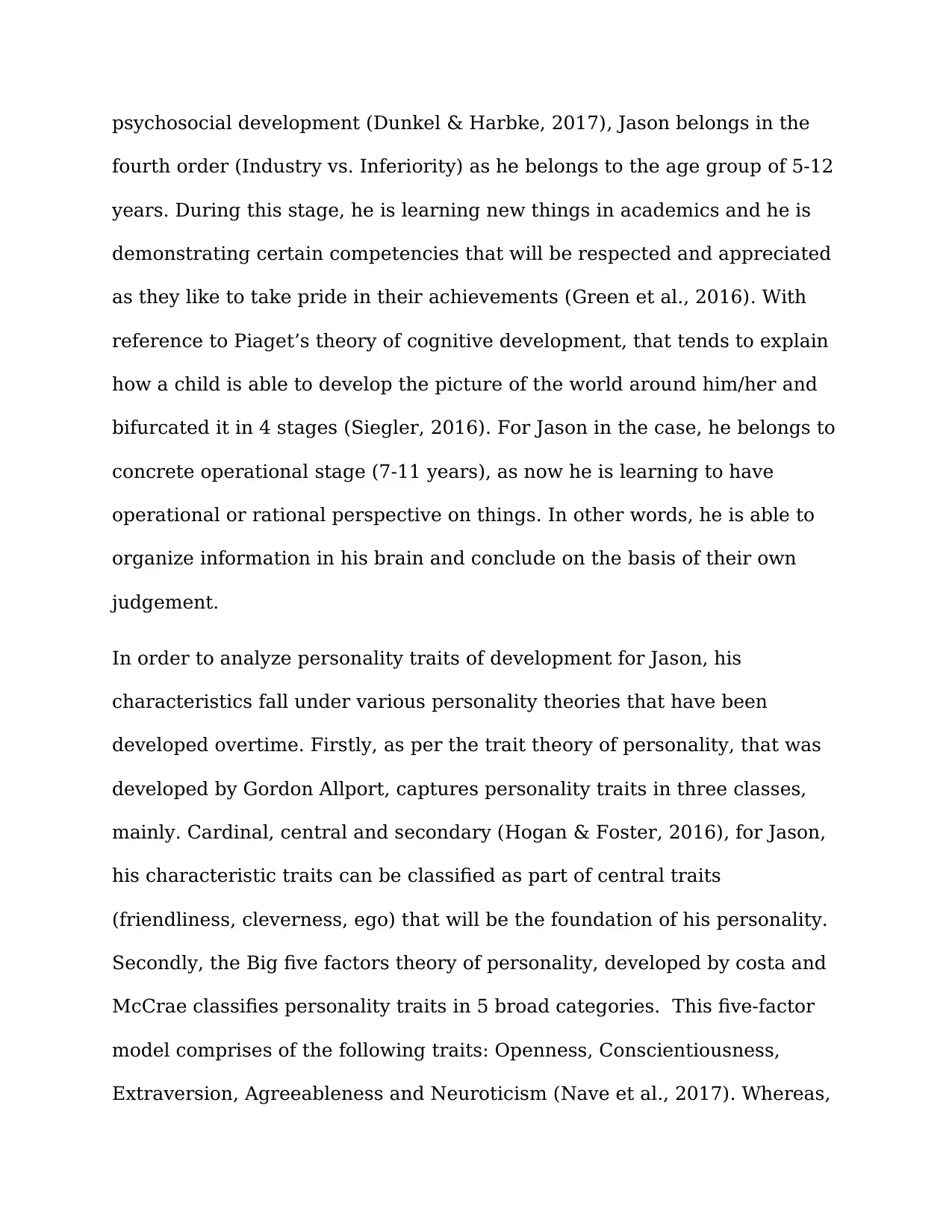
psychosocial development (Dunkel & Harbke, 2017), Jason belongs in the
fourth order (Industry vs. Inferiority) as he belongs to the age group of 5-12
years. During this stage, he is learning new things in academics and he is
demonstrating certain competencies that will be respected and appreciated
as they like to take pride in their achievements (Green et al., 2016). With
reference to Piaget’s theory of cognitive development, that tends to explain
how a child is able to develop the picture of the world around him/her and
bifurcated it in 4 stages (Siegler, 2016). For Jason in the case, he belongs to
concrete operational stage (7-11 years), as now he is learning to have
operational or rational perspective on things. In other words, he is able to
organize information in his brain and conclude on the basis of their own
judgement.
In order to analyze personality traits of development for Jason, his
characteristics fall under various personality theories that have been
developed overtime. Firstly, as per the trait theory of personality, that was
developed by Gordon Allport, captures personality traits in three classes,
mainly. Cardinal, central and secondary (Hogan & Foster, 2016), for Jason,
his characteristic traits can be classified as part of central traits
(friendliness, cleverness, ego) that will be the foundation of his personality.
Secondly, the Big five factors theory of personality, developed by costa and
McCrae classifies personality traits in 5 broad categories. This five-factor
model comprises of the following traits: Openness, Conscientiousness,
Extraversion, Agreeableness and Neuroticism (Nave et al., 2017). Whereas,
fourth order (Industry vs. Inferiority) as he belongs to the age group of 5-12
years. During this stage, he is learning new things in academics and he is
demonstrating certain competencies that will be respected and appreciated
as they like to take pride in their achievements (Green et al., 2016). With
reference to Piaget’s theory of cognitive development, that tends to explain
how a child is able to develop the picture of the world around him/her and
bifurcated it in 4 stages (Siegler, 2016). For Jason in the case, he belongs to
concrete operational stage (7-11 years), as now he is learning to have
operational or rational perspective on things. In other words, he is able to
organize information in his brain and conclude on the basis of their own
judgement.
In order to analyze personality traits of development for Jason, his
characteristics fall under various personality theories that have been
developed overtime. Firstly, as per the trait theory of personality, that was
developed by Gordon Allport, captures personality traits in three classes,
mainly. Cardinal, central and secondary (Hogan & Foster, 2016), for Jason,
his characteristic traits can be classified as part of central traits
(friendliness, cleverness, ego) that will be the foundation of his personality.
Secondly, the Big five factors theory of personality, developed by costa and
McCrae classifies personality traits in 5 broad categories. This five-factor
model comprises of the following traits: Openness, Conscientiousness,
Extraversion, Agreeableness and Neuroticism (Nave et al., 2017). Whereas,
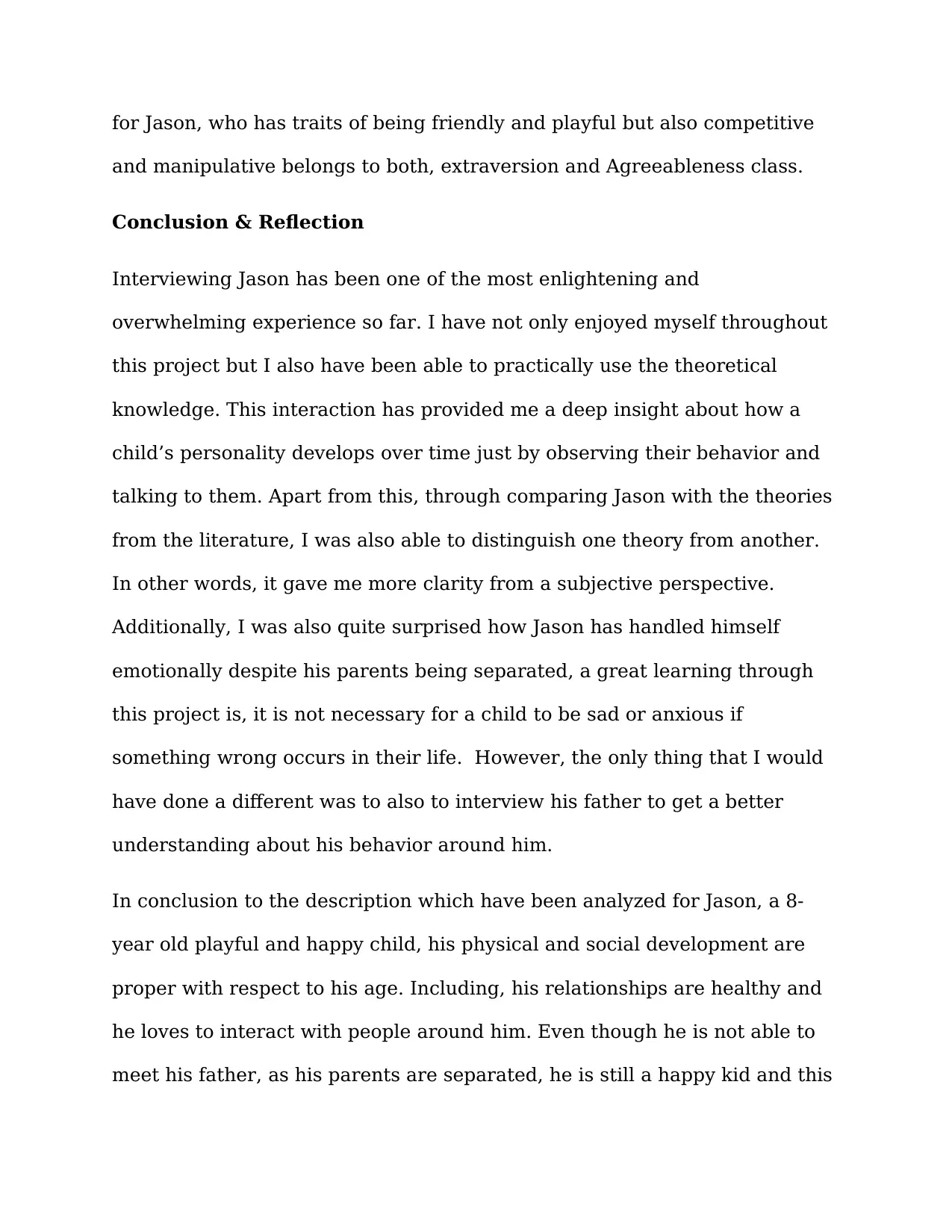
for Jason, who has traits of being friendly and playful but also competitive
and manipulative belongs to both, extraversion and Agreeableness class.
Conclusion & Reflection
Interviewing Jason has been one of the most enlightening and
overwhelming experience so far. I have not only enjoyed myself throughout
this project but I also have been able to practically use the theoretical
knowledge. This interaction has provided me a deep insight about how a
child’s personality develops over time just by observing their behavior and
talking to them. Apart from this, through comparing Jason with the theories
from the literature, I was also able to distinguish one theory from another.
In other words, it gave me more clarity from a subjective perspective.
Additionally, I was also quite surprised how Jason has handled himself
emotionally despite his parents being separated, a great learning through
this project is, it is not necessary for a child to be sad or anxious if
something wrong occurs in their life. However, the only thing that I would
have done a different was to also to interview his father to get a better
understanding about his behavior around him.
In conclusion to the description which have been analyzed for Jason, a 8-
year old playful and happy child, his physical and social development are
proper with respect to his age. Including, his relationships are healthy and
he loves to interact with people around him. Even though he is not able to
meet his father, as his parents are separated, he is still a happy kid and this
and manipulative belongs to both, extraversion and Agreeableness class.
Conclusion & Reflection
Interviewing Jason has been one of the most enlightening and
overwhelming experience so far. I have not only enjoyed myself throughout
this project but I also have been able to practically use the theoretical
knowledge. This interaction has provided me a deep insight about how a
child’s personality develops over time just by observing their behavior and
talking to them. Apart from this, through comparing Jason with the theories
from the literature, I was also able to distinguish one theory from another.
In other words, it gave me more clarity from a subjective perspective.
Additionally, I was also quite surprised how Jason has handled himself
emotionally despite his parents being separated, a great learning through
this project is, it is not necessary for a child to be sad or anxious if
something wrong occurs in their life. However, the only thing that I would
have done a different was to also to interview his father to get a better
understanding about his behavior around him.
In conclusion to the description which have been analyzed for Jason, a 8-
year old playful and happy child, his physical and social development are
proper with respect to his age. Including, his relationships are healthy and
he loves to interact with people around him. Even though he is not able to
meet his father, as his parents are separated, he is still a happy kid and this

did not affect his social life. He has fruitfully made it through Erikson’s
industry vs. inferiority developmental stage. He is also developing
competence while he passes through this stage. However, his needs to
develop his cognition and personality as he is not keen on listening
(egocentrism) to other people and is slightly dominant when it comes to
changing his ways to acknowledge academics because of which his studies
are being affected. However, he will eventually improve and progress if
right approach and guidance is provided.
industry vs. inferiority developmental stage. He is also developing
competence while he passes through this stage. However, his needs to
develop his cognition and personality as he is not keen on listening
(egocentrism) to other people and is slightly dominant when it comes to
changing his ways to acknowledge academics because of which his studies
are being affected. However, he will eventually improve and progress if
right approach and guidance is provided.
Secure Best Marks with AI Grader
Need help grading? Try our AI Grader for instant feedback on your assignments.
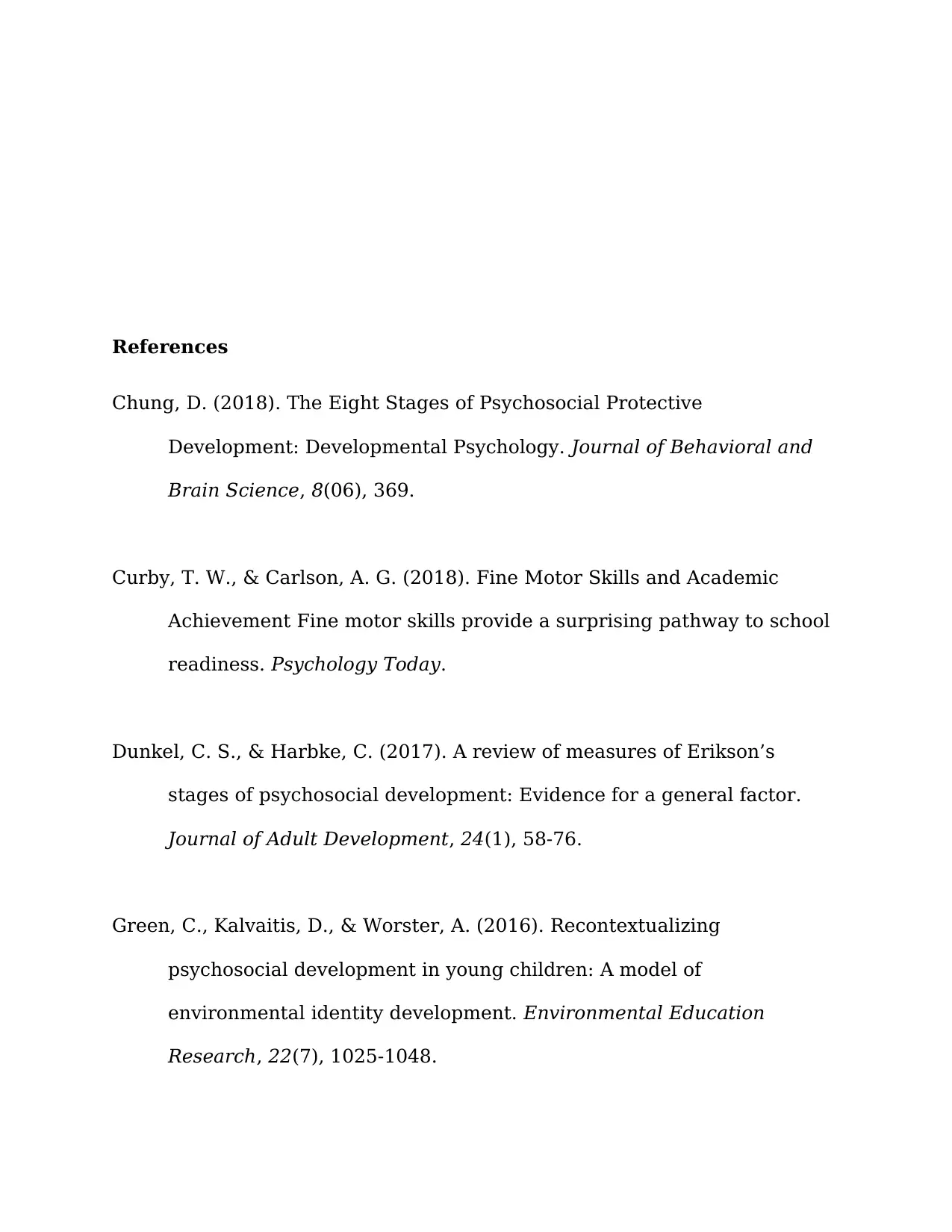
References
Chung, D. (2018). The Eight Stages of Psychosocial Protective
Development: Developmental Psychology. Journal of Behavioral and
Brain Science, 8(06), 369.
Curby, T. W., & Carlson, A. G. (2018). Fine Motor Skills and Academic
Achievement Fine motor skills provide a surprising pathway to school
readiness. Psychology Today.
Dunkel, C. S., & Harbke, C. (2017). A review of measures of Erikson’s
stages of psychosocial development: Evidence for a general factor.
Journal of Adult Development, 24(1), 58-76.
Green, C., Kalvaitis, D., & Worster, A. (2016). Recontextualizing
psychosocial development in young children: A model of
environmental identity development. Environmental Education
Research, 22(7), 1025-1048.
Chung, D. (2018). The Eight Stages of Psychosocial Protective
Development: Developmental Psychology. Journal of Behavioral and
Brain Science, 8(06), 369.
Curby, T. W., & Carlson, A. G. (2018). Fine Motor Skills and Academic
Achievement Fine motor skills provide a surprising pathway to school
readiness. Psychology Today.
Dunkel, C. S., & Harbke, C. (2017). A review of measures of Erikson’s
stages of psychosocial development: Evidence for a general factor.
Journal of Adult Development, 24(1), 58-76.
Green, C., Kalvaitis, D., & Worster, A. (2016). Recontextualizing
psychosocial development in young children: A model of
environmental identity development. Environmental Education
Research, 22(7), 1025-1048.
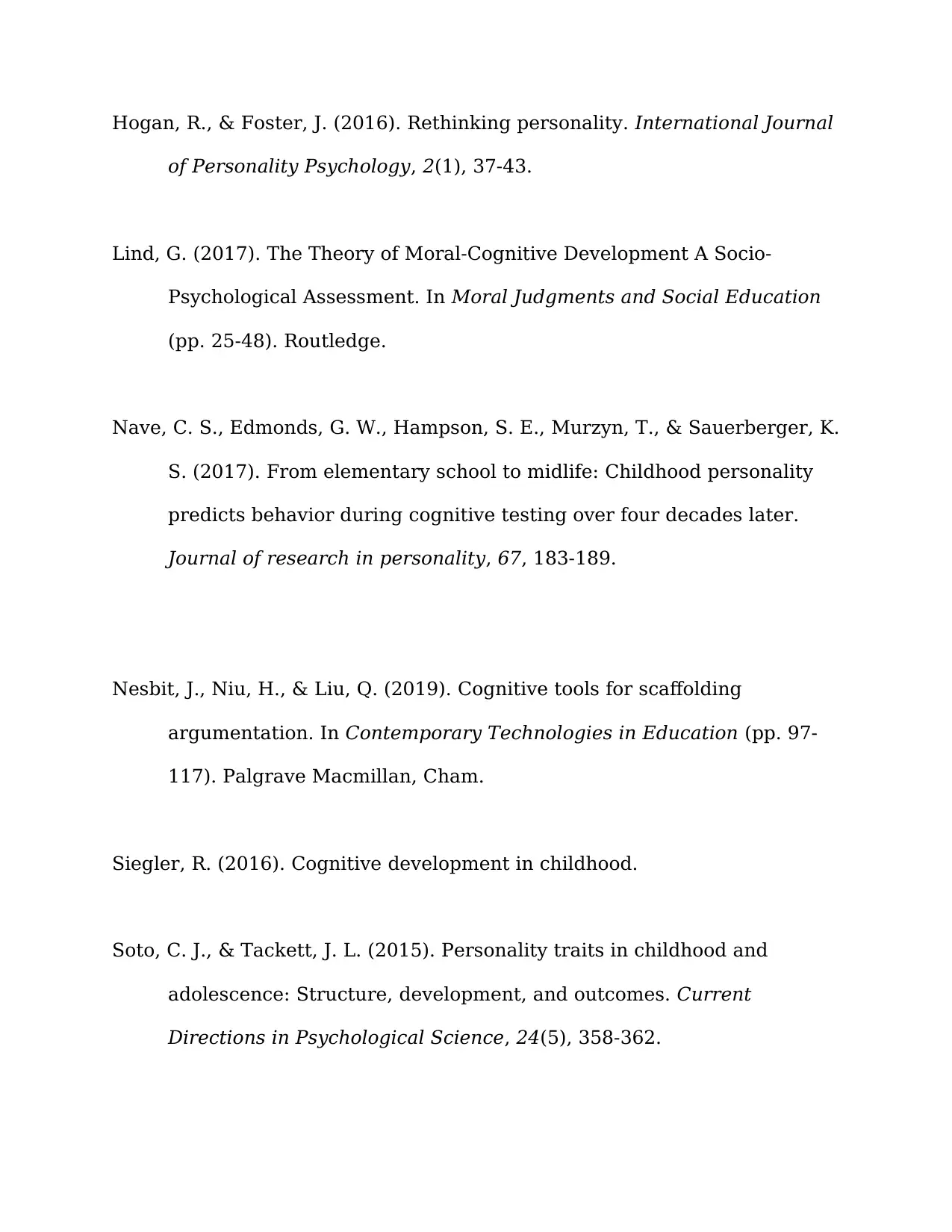
Hogan, R., & Foster, J. (2016). Rethinking personality. International Journal
of Personality Psychology, 2(1), 37-43.
Lind, G. (2017). The Theory of Moral-Cognitive Development A Socio-
Psychological Assessment. In Moral Judgments and Social Education
(pp. 25-48). Routledge.
Nave, C. S., Edmonds, G. W., Hampson, S. E., Murzyn, T., & Sauerberger, K.
S. (2017). From elementary school to midlife: Childhood personality
predicts behavior during cognitive testing over four decades later.
Journal of research in personality, 67, 183-189.
Nesbit, J., Niu, H., & Liu, Q. (2019). Cognitive tools for scaffolding
argumentation. In Contemporary Technologies in Education (pp. 97-
117). Palgrave Macmillan, Cham.
Siegler, R. (2016). Cognitive development in childhood.
Soto, C. J., & Tackett, J. L. (2015). Personality traits in childhood and
adolescence: Structure, development, and outcomes. Current
Directions in Psychological Science, 24(5), 358-362.
of Personality Psychology, 2(1), 37-43.
Lind, G. (2017). The Theory of Moral-Cognitive Development A Socio-
Psychological Assessment. In Moral Judgments and Social Education
(pp. 25-48). Routledge.
Nave, C. S., Edmonds, G. W., Hampson, S. E., Murzyn, T., & Sauerberger, K.
S. (2017). From elementary school to midlife: Childhood personality
predicts behavior during cognitive testing over four decades later.
Journal of research in personality, 67, 183-189.
Nesbit, J., Niu, H., & Liu, Q. (2019). Cognitive tools for scaffolding
argumentation. In Contemporary Technologies in Education (pp. 97-
117). Palgrave Macmillan, Cham.
Siegler, R. (2016). Cognitive development in childhood.
Soto, C. J., & Tackett, J. L. (2015). Personality traits in childhood and
adolescence: Structure, development, and outcomes. Current
Directions in Psychological Science, 24(5), 358-362.

Van der Fels, I. M., te Wierike, S. C., Hartman, E., Elferink-Gemser, M. T.,
Smith, J., & Visscher, C. (2015). The relationship between motor skills
and cognitive skills in 4–16-year-old typically developing children: A
systematic review. Journal of science and medicine in sport, 18(6),
697-703.
Smith, J., & Visscher, C. (2015). The relationship between motor skills
and cognitive skills in 4–16-year-old typically developing children: A
systematic review. Journal of science and medicine in sport, 18(6),
697-703.
1 out of 13
Related Documents
Your All-in-One AI-Powered Toolkit for Academic Success.
+13062052269
info@desklib.com
Available 24*7 on WhatsApp / Email
![[object Object]](/_next/static/media/star-bottom.7253800d.svg)
Unlock your academic potential
© 2024 | Zucol Services PVT LTD | All rights reserved.





